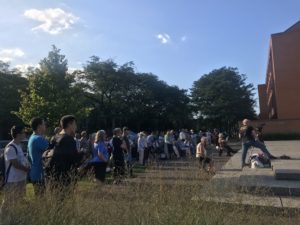
In this piece, artist Irene Hsiao walks us through her ensemble’s recent dance performance at the Annual August 6th Remembrance of Nagasaki and Hiroshima—a gathering of activists from environmental, nuclear nonproliferation, and anti-war organizations. Her dance, as well as the songs and poems also reflecting on nuclear catastrophe, demonstrates how artistic expression can illuminate, activate, validate, and interrogate our feelings about global crises that are often overwhelming without the aid of art. The Futures Design Challenge encourages teams to think about how such performances and displays can move people to action, and it welcomes out-of-the-box solutions to the issue of climate change. Songs, poems, and dances are just as necessary as technological innovations to confront the future of our planet.

People gather to remember Hiroshima and Nagasaki

